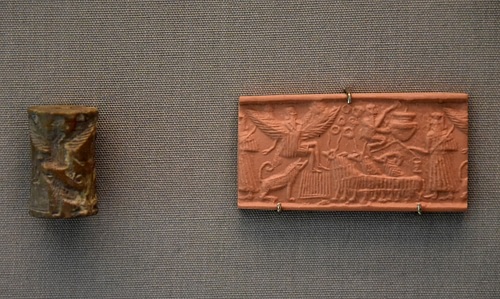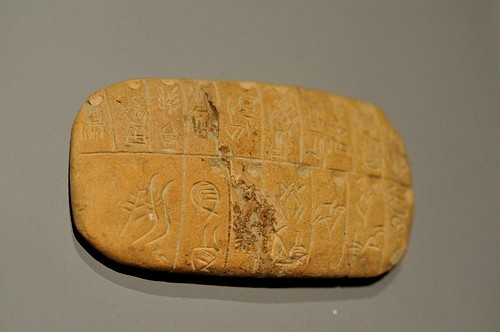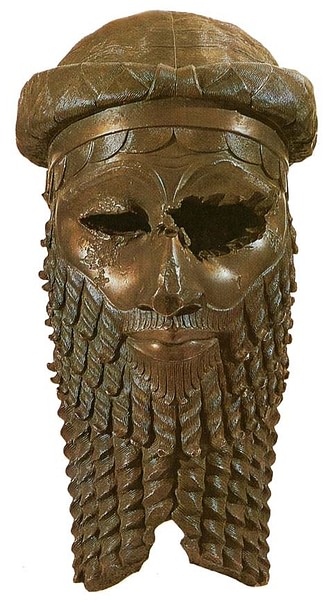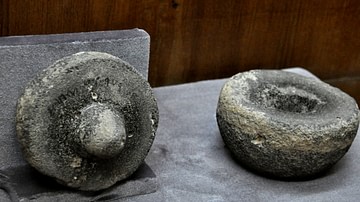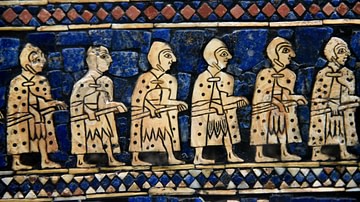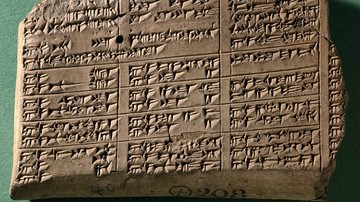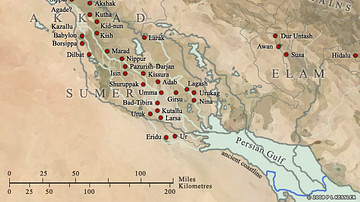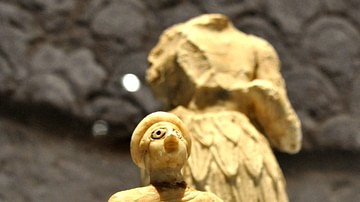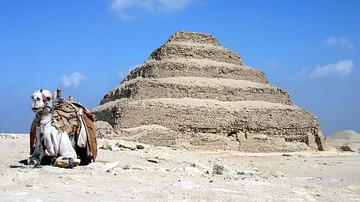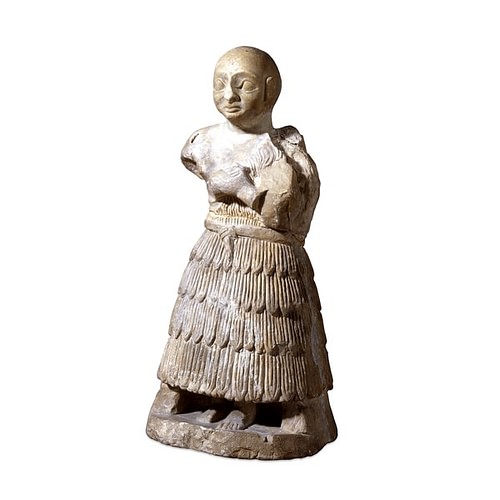
The Early Dynastic Period of Mesopotamia is the modern-day archaeological term for the era in Mesopotamian history – 2900-2334 BCE – during which some of the most significant cultural advances were made including the rise of the cities, the development of writing, and the establishment of governments.
This era was preceded by the Uruk Period (4100-2900 BCE) when the first cities were established in the region of Sumer (southern Mesopotamia) and succeeded by the Akkadian Period (2334-2218 BCE) when Mesopotamia was conquered by Sargon of Akkad (r. 2334-2279 BCE) and ruled by him and his successors as the Akkadian Empire.
The term Early Dynastic Period was coined by Orientalist Henri Frankfort (l. 1897-1954 CE) to mirror the Early Dynastic Period in Egypt, a similar period of development. It should be noted, however, that the advances of Mesopotamia's Early Dynastic Period differed from Egypt's in significant ways, notably in that Mesopotamia – even under the rule of Sargon or later empires – was never the cohesive ethnic or political entity Egypt was and the kinds of cultural development cited for this era were not as uniform as they were in Egypt.
The city-states of Sumer were, for much of their history, each independently governed – not united under the reign of a single king as in the case of Egyptian government – and so a city like Uruk or Ur might have developed some important cultural advance which was not shared – at least not readily – with others.
The era is divided by archaeologists into three subperiods:
- Dynastic I – 2900-2800 BCE
- Dynastic II – 2800-2600 BCE
- Dynastic III – 2600-2334 BCE
These are considered arbitrary divisions by some scholars and historians as there is no clear demarcation line separating one from the next. Even so, there is enough of a subtle difference that division is considered justified.
Uruk Period
The earliest era in Mesopotamian history is the Ubaid Period (c. 5000-4100 BCE) about which little is known. The origins of the Ubaid people (so called because of the modern-day site, Tell al'Ubaid, where the major finds of the culture were located) are obscure, and as they left no written records, the little information archaeologists have on them comes from their pottery and artwork. They had already shifted from a hunter-gatherer society to an agrarian culture and established small rural communities before the rise of Sumer.
These villages developed during the Uruk Period (named for the central archeological site which defines the era, the city of Uruk) and, in time, became the first cities. Major advances of this period, besides urbanization, were monumental architecture (c. 3500-3300 BCE, notably the ziggurat), the development of cylinder seals (c. 3600 BCE, although the basic paradigm of the seal was already known), writing (c. 3600-3500 BCE), written language (c. 3200 BCE) which is exemplified in lexical lists (essentially scribal dictionaries of cuneiform signs and their meaning in Sumerian, Akkadian, and Hittite), and governmental bureaucracy. All of these advances became more highly developed during the Early Dynastic Period.
Early Dynastic I
Between the Uruk Period and the Early Dynastic Period, the rivers around the region of the city of Shuruppak overflowed, causing severe flooding from the southern plains up through the north. This event, which severely disrupted the society, is considered the origin of the Great Flood story as reimagined as the gods' wrath in the Eridu Genesis and the Atrahasis, the Mesopotamian works now recognized as the inspiration for the famous tale of Noah and his ark from the Bible. The exact date of the flood is contested but most scholars set it at c. 2900 BCE.
The cities which existed before the flood were:
- Eridu
- Bad-tibira
- Larsa
- Sippar
- Shuruppak
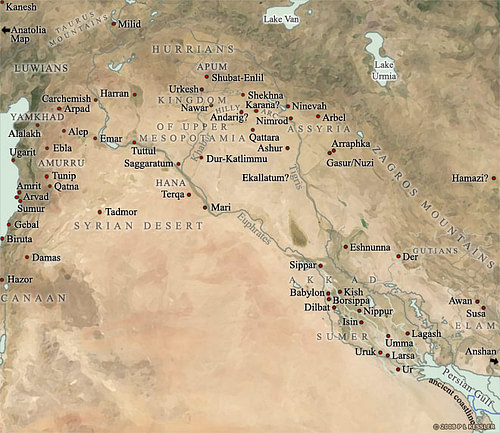
The cities established after the flood were:
The Sumerian King List – a document composed c. 2100 BCE at Lagash – claims the first city, established by the gods, was Eridu and the first king was Alulim who reigned for 28,800 years. The kings who follow Alulim are mostly all given equally improbable lengths of reign. The first king on the list considered historical is Etana of Kish, best known from The Myth of Etana, a work belonging to the genre of Mesopotamian Naru Literature in which Etana flies to heaven on the back of an eagle to win what he desires most from the gods.
The Sumerian King List notes that the kingship passed from Eridu to other cities and the list was composed to create an unbroken line between the present kingship and the illustrious past going all the way back to Eridu. The dates of most of these kings are doubtful and their length of reign is impossible, but it is clear that the cities of Mesopotamia developed steadily from the foundation of Eridu c. 5400 BCE throughout Early Dynastic I.
These cities, as noted, grew from small villages but the core of those villages – as evidenced by administrative records – was a social organization known as a 'household'. Scholar Marc van de Mieroop explains:
[Households were] social units larger than nuclear families whose members reside together. An important aspect of the household is the fact that it acted as a single unit of production and consumption: most goods needed for its survival were produced in the household itself. Households may have originated in economically autonomous kinship groups and eventually coalesced into institutions centered around a god or the king. (55)
Households were associated either with the god of the city (represented by the temple on top of the ziggurat), the king, the queen, or someone of substantial wealth and power. Each household held its particular land and assets (such as boats and tools) in common. In the Uruk Period, the priests essentially ruled but kingship had been established c. 3600 BCE and, by the time of Dynastic I, this position was firmly established. The king took care of the people and the high priest took care of the god of the city. Lesser priests tended to the temple complex and ministered to the needs of the people.
Each household followed the same hierarchy following that of the king at the top, then the queen (who sometimes had her own household), the priests of the city's god, the military, administration/bureaucracy, merchant and artisan class (skilled workers), and the unskilled workers (laborers) at the bottom. Laborers were paid through rations distributed by the administrator of the king, queen, or temple and usually consisted of barley, wool, and oil. People also fished and cultivated private gardens to supplement their income. Marc van de Mieroop comments on the rations provided:
It is clear that these rations constituted the support given to the household's dependents, whether productive or not. The amounts were provided according to the sex and status of the worker: a male worker regularly received double the amount of grain given to a female worker, supervisors received more than their subordinates, specialized craftsmen more than unskilled laborers, and so on. (57)
Although Sumerian women had nearly equal rights, this paradigm did not extend to the lowest classes who had few rights overall. The policy and practices of the household would remain a constant as the early cities of Dynastic I developed and became the powerful city-states of Dynastic II.
Early Dynastic II
The Dynastic II Period saw the development of these earlier advances as the individual cities expanded. Technology was improved and the household paradigm maintained a cohesive structure for the developing culture. Scholar Wolfram von Soden comments:
[The culture was based on] the formation of a society based on a division of labor which freed large groups of the population – such as artisans, merchants, and cultic and administrative personnel – from the production of food, as well as on an advanced technology for the production of clay vessels using the potter's wheel, metallurgy, and the mass production of heavily used objects. (15)
The stability provided by the household model allowed for the cultural expansion which necessitated invention and innovation. Ceramics and metallurgy were produced en masse while jewelry of precious gems became a mainstay for the upper class as did fine cloth woven by the laborers.
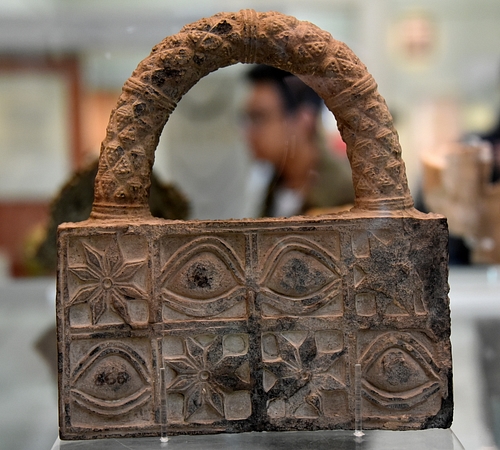
This model worked well for the upper class, and the mass-produced items, bread, and woven cloth were also lucrative trade items, but this wealth never trickled down to the lower-class laborers who produced the merchandise. Marc van de Mieroop explains:
The majority of workers provided repetitive manual labor. Women were especially used as millers and weavers. Milling at this time was a backbreaking task which required that grain be rubbed back and forth over a stone slab with a smaller hand-held stone. The women were supposed to produce set quotas on a daily basis…[later] weaving quotas could easily be as high as 2 square meters a day. Those were heavy tasks, that could lead to physical injuries, as is shown by the skeletons of women. (58)
As the wealth and power of the cities grew, they attracted more and more people from rural areas. Cities afforded protection from raiders, slavers, and the elements in addition to providing opportunities for work which, at first anyway, seemed preferable to trying to scratch out a living as an independent farmer. Those who remained in rural communities were left with the burden of providing at least the same amount of grain to the cities – and then increasingly more – than they had before. Scholar Gwendolyn Leick notes:
As the city grew larger and more populous, attracting more and more people eager to escape the drudgery of subsistence farming, and perhaps also the narrow horizons of traditional communities, the demands on the remaining rural population increased. Tension and unrest seem to have been met with violent repression; pictorial scenes on seals and other objects show groups of prisoners, their hands bound behind their backs. (55)
These scenes clearly depict fellow citizens, not foreign prisoners held as slaves, but nothing was done to stop this practice because of the very same model of the household which held society together. The upper-class heads of the households maintained large estates and the workers on those lands were expected to produce to the households' expectations. This placed a tremendous burden on the workers to the extent that they seem to have seen the mundane work in the city as preferable.
Further, as Leick notes, “the climate changed so that much less water was carried by the rivers [and] may have prompted even more people to seek their survival in the city” (55). Each city rivaled the next in population growth and, as cities became wealthier, they desired even more. Around 2700 BCE, Enmebaragesi of Kish led the Sumerian cities in a war against Elam – the first war in recorded history – and defeated the Elamites, carrying back the spoils to Sumer. This is one example of the city-states working together for a common goal but, as scholar Samuel Noah Kramer points out, they had needed to find a way to do that – individually and collectively – long before the war and it was this need for cooperation, in fact, which had given rise to the city-states to begin with:
While the Sumerians set a high value on the individual and his achievement, there was one overriding factor which fostered a strong spirit of cooperation among individuals and communities alike: the complete dependence of Sumer on irrigation for its well-being – indeed, for its very existence. Irrigation is a complicated process requiring communal effort and organization. Canals had to be dug and kept in constant repair. The water had to be divided equitably among all concerned. To ensure this, a power stronger than the individual landowner or even the single community was mandatory: hence, the growth of governmental institutions and the rise of the Sumerian state. (Sumerians, 5)
When they had to, the city-states cooperated and were able to accomplish their goals. Apart from necessary cooperation for survival, however – and this would include trade agreements – the cities pursued their own self-interest, often to the detriment of others.
Early Dynastic III
The Early Dynastic III Period witnessed the rise of Kish in the north and Uruk in the south as the two dominant political powers. This is the era in which the kings are best historically/archaeologically attested but, still, the dynasties of some cities, like Lagash, are not included in the Sumerian King List and the dates of that list for other kings often do not correspond to dates in other documents or the archaeological record.
The great kings of Uruk, for example, such as Meshkianggasher, Enmerkar (who was said to have first founded Uruk), Lugalbanda, Dumuzi, and the great hero-king Gilgamesh are all listed toward the beginning of the Early Dynastic III Period c. 2600 BCE but are also associated with earlier rulers such as Enmebaragesi and later kings like Eannatum (c. 2500-2400 BCE). There seems to be no reconciling these differences in chronology.
The first king of the First Dynasty of Lagash, Ur-Nanshe, established Lagash as a strong political presence and his son Eannatum would expand on his policies and conquer all of Sumer. Eannatum, calling upon Enlil (patron god of Lagash) and Ninurta (god of war) led his armies against the other city-states and conquered all of Sumer – including Uruk and Kish – and then moved against the Elamites and took large portions of their territory. By the time his campaigns were over, he had created the first empire in Mesopotamia, largely comprised of the city-states of his former-fellow-monarchs. His empire was challenged shortly after his death, however, and his successors could not maintain it.
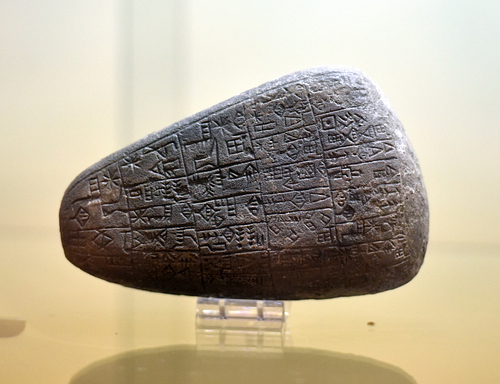
One of the most interesting – and mysterious – of the monarchs who are said to have freed their cities from the empire of Lagash is the only female ruler on the Sumerian King List: Kubaba (also given as Kug-Bau), who founded the Third Dynasty of Kish. The Sumerian King List describes her briefly as “the woman tavern-keeper who made firm the foundations of Kish”. Who she was, where she came from, and how she came to power is unknown.
Her son, Puzur-Suen, and grandson, Ur-Zababa, were both successful kings and Kubaba herself was deified after her death. Her cult, in fact, would inform the later goddess of the Hurrians (Hepat) and, famously, the Phrygian mother goddess Matar Kubileya (“Mother Cybele”) who was worshipped by the Ionian Greeks of Anatolia/Cilicia as Cybele.
The Akkadian Period
Whatever the royal accomplishments of her grandson Ur-Zababa were, they were eclipsed by the legends which came to define the reign of the man who enters history as his cupbearer. Sargon of Akkad's 'biography' – which scholars consider a highly mythologized version of events – claims that he was born in the north, the illegitimate son of a “changeling”, who gave birth to him in secret and then set him afloat on the river in a basket of reeds which brought him to the city of Kish where he was found by the royal gardener Akki. Sargon grew up in the palace and rose to the prestigious position of cupbearer to Ur-Zababa who favored him until the king had a disturbing dream suggesting Sargon would depose him.
At about this same time, the king of the city-state of Umma, Lugalzagesi, embarked on a campaign of conquest to reunite Sumer under a single ruler – himself – just as Eannatum had earlier. Ur-Zababa sent Sargon as an emissary to Lugalzagesi, who was on the march toward Kish, possibly with terms, but according to legend, with the request that the king of Umma kill the messenger. Sargon so impressed Lugalzagesi, however, that the king ignored the request and asked Sargon to join him. They marched on Kish together and took it; Ur-Zababa fled the city and nothing more is known of him.
Shortly after this, Sargon turned on his benefactor and defeated him, dragging him in chains, with a rope around his neck, to the city of Nippur where he was publicly humiliated in being marched through the sacred gate of the god Enlil – in whom Lugalzagesi had trusted for victory – and then, presumably, executed. Sargon then proclaimed himself king and went on to conquer all of Mesopotamia and found the Akkadian Empire, the first multi-national political entity in history.
Conclusion
The Akkadian Empire brings the Early Dynastic Period to a close but, contrary to Sargon's later boasts and the legends that grew up around him, he could not have established his empire without the foundation laid by his predecessors. Sargon's greatest strength, in fact, was learning from the mistakes of the earlier conquerors and placing people he could trust in positions of authority throughout his empire – including his daughter Enheduanna (l. 2285-2250 BCE), high priestess of the temple of Inanna at the city of Ur and the first author in history known by name – as well as routinely sending trusted officials throughout his realm to maintain order.
Sargon's example would be followed by the later Assyrian Empire and the Roman Empire in terms of cohesive government. The model of that government, however, was set down by the Sumerian kings of the Early Dynastic Period. These monarchs established a society which, in spite of its weaknesses and rivalries, allowed for the development of many of the most fundamental aspects of civilization so often taken for granted in the present day.
